What are predatory mites, Stratiolaelaps scimitus?
The predatory mites, Stratiolaelaps scimitus are also called as Hypoaspis miles. These mites are well known natural enemies of crop pests including fungus gnats, two-spotted spider mites and thrips. Both adults and larvae of S. scimitus mites look identical with clear brown to tan in color and four pairs of leggs. Both stages feed on the different stages of their hosts. When predatory S. scimitus mites are released in the pots containing plants, they will quickly disperese in the potting medium and on the plant surface to find their hosts and feed on them. These mites are very effective in controlling fungus gnats, thrips and two-spotted predatory mites in the closed structures like homes and greenhouses because the optimum temperatures between 15°C and 25°C (59°F and 77°F) required for their survival, maximum activity, reproduction and development can be easily maintained in these structures.
Following three crop pests are easily controlled with Stratiolaelaps scimitus
1. Fungus gnats
Fungus gnats (Bradysia spp.) are one of the most damaging pests of many flowering ornamentals including poinsettias, geraniums, lilies and chrysanthemums that are mainly grown in commercial greenhouses. Fungus gnats are also serious pests of many house hold plants. Fungus gnat adults are tiny about 3-4 mm long, blackish to grayish in colored flies with clear wings (Photo 1). The larval stages of fungus gnats are also called as maggots that are legless, and whitish in color with black head capsules (Photo 2). Maggots can be found just 1-2 inch below the surface of the potting medium or soil. Only maggots of fungus gnats that known to cause direct feeding damage to the roots and stems of the host plants. While feeding, the maggots often chew or strip roots and tunnel stems. This type of damage generally affects the water and nutrient absorption capacity of the injured plants that leades into the loss of vigor and eventuially the death of plants. During feeding maggots also transmit fungal pathogens like Fusarium, Pythium and Verticillium. In contrast, adult fungus gnat flies do not feed on the plant tissues but they can cause indirect damage to plants by disseminating disease causing spores of fungal pathogens like Fusarium, Pythium and Verticillium from plant to plant as they disperse through the greenhouse. Adult flies are also nuisance to the people in the houses and the greenhouse workers.
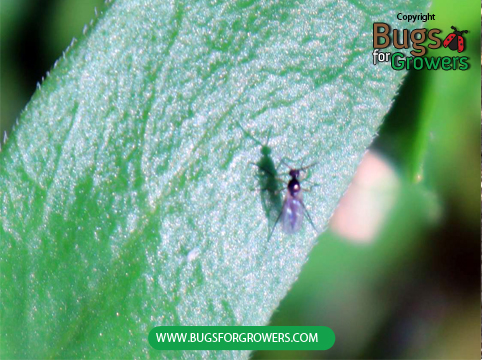
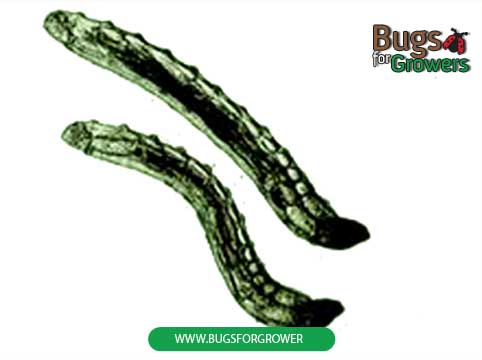
2. Two-spotted spider mites
Two-spotted spider mites (Photo 3) are the most damaging pests of different types fruits, vegetables, and ornamental plants. These mites are called as spider mites or webspinning mites becuase they spin web on the plants like spiders (Photo 5). The most economically important species of spider (webspinning) mites include two-spotted spider mite (Tetranychus urticae), Pacific mite (Tetranychus pacificus), Carmine red mite (Tetranychus cinnabarinus) and Strawberry spider mite (Tetranychus turkestani). All the species of spider mites mainly feed by sucking cell sap (juice) from leaves and buds. Feeding injury by spider mites generally gives mottled and speckled appearances to leaves (Photo 4). Also, heavy mite infestation can cause yellowing and drying of leaves, pre-mature leaf drop, plant death and loss of crop yields. In addition, the feeding activity of mites can affect the photosynthesis reducing plant’s ability to make its own food. Furthermore, webspinning (Photo 5) by spider mites reduces aesthetic and market values of many beautiful flowering and leafy ornamentals costing millions of dollars of loss to agricultural, horticultural and ornamental industries.
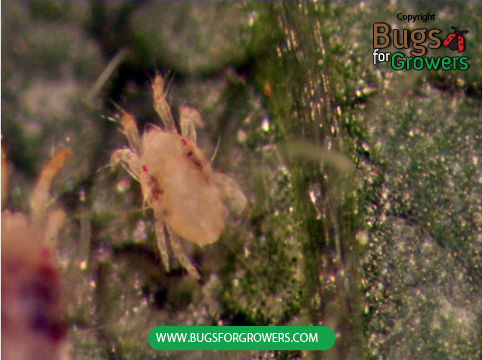
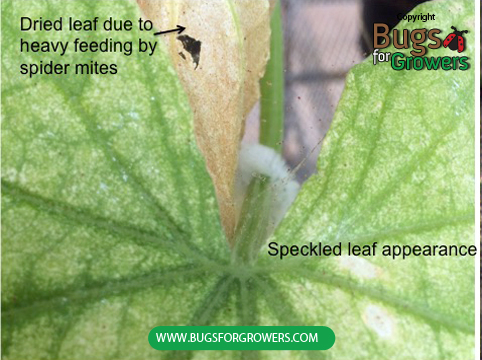
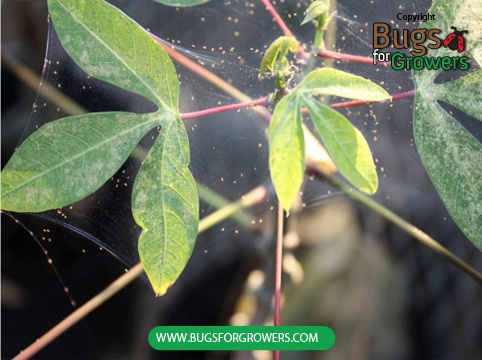
3. The Western flower thrips
The Western flower thrips (Frankliniella occidentalis) are also one of the the most destructive pests of greenhouse crops and ornamental plants. The Western flower thrips are tiny about 1-2 mm long slender bodied insects with two pairs of wings. All the species of thrips generally reproduce either sexually or asexually even though both the males and females are present their lifecycle. Females generally lay eggs into leaf or bud tissues. Eggs hatch into tiny nymphs (Photo 6) that are wingless and develop through two developmental stages. The matured larvae pupate either in the soil, plant crevices or on the leaves. Adults emerge from pupae within 6-7 days. Both adults and nymphs use their rasping and sucking types of mouthparts to puncture outer layer of rapidly growing young leaf, flower and fruit tissues and suck the sap (juice) from the punctured cells. The damage caused by thrips is termed as “stippling” the feeding scars left on the buds, leaves, flowers, fruits and twigs. The symptoms of heavy feeding by thrips include stunted plant growth, curling and folding and discoloration of leaves (Photo 7), buds and flowers. The damaged leaves and flower petals can drop prematurely. While feeding, thrips also scatter their feces on the leaves and flowers that reduces aesthetic and market values of ornamental plants causing a tremendous economic loss to the greenhouse industry. Thrips are also known to transmit disease causing plant viruses that can cause severe economic losses to many crops and ornamental plants.
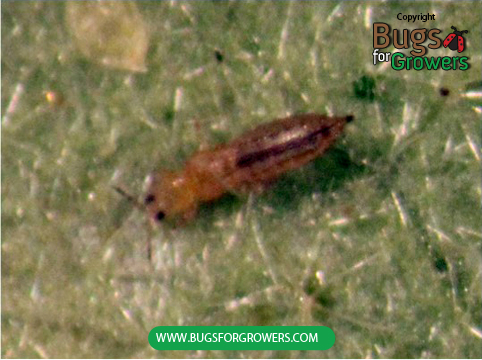
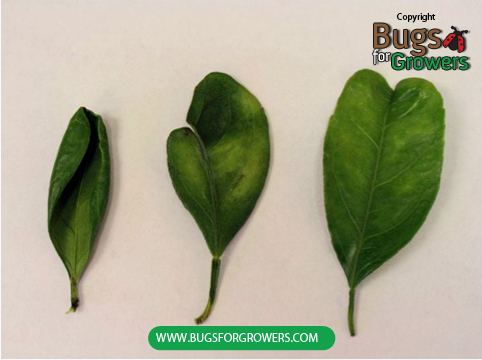
How many and how to release Stratiolaelaps scimitus (Hypoaspis miles)?
For the effective control of each of the crop pests including fungus gnats, two-spotted spider mites and the western flower thrips release:
- 5-10 predatory mites per square feet (0.1 sq. meter) area bi-weekly, 2-3 times or
- 25,000 to 50,000 predatory mites/acre, bi-weekly, 2-3 times.
- Release these mites by opening the containers and sprinkling the mixture of media containing predatory mites on the surface of soil or potting media.
How predatory mites, Stratiolaelaps scimitus (Hypoaspis miles) will control crop pests?
- Once these mites are released in the greenhouses, they will move fast throughout the soil or media profile or on the plant surface where they will seek different stages of different hosts.
- When predatory mites are appliedon the surface of soil or potting media for controlling fungus gnats, they will move into the soil or potting medium where they will find fungus gnat maggots and feed on them
- When predatory mites are released on the surface of the plants for either controlling two-spotted spider mites or the western flower thrips, they will quickly find all the stages of both crop pests and feed directly on them.
